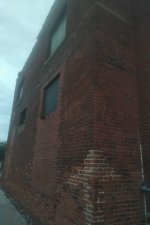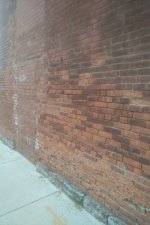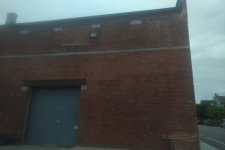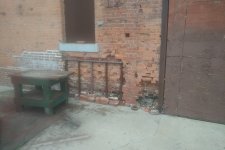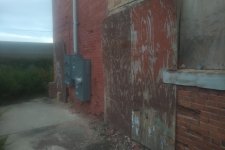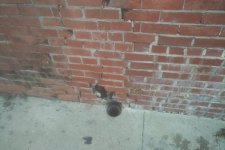Cough, cough, move along, move along.
Star fort central.
View attachment 12160
In my opinion a
bullsh*t story over here about that canal (for mills).
I think they found an already operating power system in this whole area and they just bought/ stole/ ? it.
At the moment it is too much to collect and post here, but the Rockefeller, Astor, Vanderbilt were all involved here with electricity, trains, etc.
PDF about Tesla and his power plant in Buffalo.
A story how Rockefeller just missed a train to Buffalo that got a terrible accident.
Darn it, you guys, I wasn't gonna post this here in this thread, but it's relevant to your comments. Basically, I'm inclined to agree with Jinxy's premise about the area being an operating power station... I'm not willing to concede (yet) that it was all functional or anything. Maybe all was left were foundations and canals that had to be dug out a bit... but even aside from that hydraulic canal segment, was perhaps this entire section of the canal part of an old world power system? (Makes more sense than funneling ship traffic through that lane, in my opinion). Or maybe, it was a buried road, like Pompeii (or Pompeii's road wasn't a road primarily either? Many possibilities.
Anyway, now I have a point here relate about star forts and the
Great Lakes themselves possibly being recent phenomenon... but it's going to take some work to get to it. Ultimately, this doesn't really belong in this thread, but again, I think this can contextualize some of what I'm starting to think about the roll-out of electricity and the subsequent historical narrative that's been produced (both in the mainstream and alternative communities). First, let's look at Tesla's "work" and this notion of the Niagara Falls project being historical with the selecting Buffalo to become "
the first city in the world to receive long-distance alternating current (AC) electricity which led eventually to the electrification of the globe [sic]."
Marker at Tesla dedication site in Buffalo, NY
Tesla gets a lot of play, what about
George Westinghouse? He was the boss here. The wiki reminds me of a few other geniuses we know:
George Westinghouse was born in 1846 in Central Bridge, New York (see George Westinghouse Jr. Birthplace and Boyhood Home), the son of Emeline (Vedder) and George Westinghouse Sr., a machine shop owner. His ancestors came from Westphalia in Germany, who first moved to England and then emigrated to the US. The name had been Anglicized from Westinghausen....
...
Westinghouse was 19 years old when he created his first invention, the rotary steam engine. He also devised the
Westinghouse Farm Engine. At age 21 he invented a "car replacer", a device to guide derailed railroad cars back onto the tracks, and a
reversible frog, a device used with a railroad switch to guide trains onto one of two tracks....
At about this time, he witnessed a train wreck where two engineers saw one another, but were unable to stop their trains in time using the existing brakes. Brakemen had to run from car to car, on catwalks atop the cars, applying the brakes manually on each car
.[citation needed] <----Left that for emphasis.
In 1869,
at age 22, Westinghouse invented a railroad braking system using compressed air. The Westinghouse system used a compressor on the locomotive, a reservoir and a special valve on each car, and a single pipe running the length of the train (with flexible connections) which both refilled the reservoirs and controlled the brakes, allowing the engineer to apply and release the brakes simultaneously on all cars. It is a failsafe system, in that any rupture or disconnection in the train pipe will apply the brakes throughout the train. It was patented by Westinghouse on October 28, 1873...
Clever boy. Again, we tend to hear a lot about Tesla nowadays, but all this happened before Tesla even joined Westinghouse (remember, Buffalo gets illuminated in 1896):
The Westinghouse company installed 30 more AC-lighting systems within a year and by the end of 1887 it had 68 alternating current power stations to Edison's 121 DC-based stations.
So, Tesla just figured out how to get it to go further, his engine was more ideal. You know, actually, the entire history of alternating current is sort of interesting, bearing in mind that Westinghouse had installed 38 power stations by the end of 1886:
Alternating current technology was rooted in Michael Faraday's and Joseph Henry's 1830–31 discovery that a changing magnetic field can induce an electric current in a circuit. Faraday is usually given credit for this discovery since he published his findings first.
In 1832, French instrument maker Hippolyte Pixii generated a crude form of alternating current when he designed and built the first alternator. It consisted of a revolving horseshoe magnet passing over two wound-wire coils.
Then a long gap?
Because of AC's advantages in long-distance high voltage transmission, there were many inventors in the United States and Europe during the late 19th century trying to develop workable AC motors. The first person to conceive of a rotating magnetic field was Walter Baily, who gave a workable demonstration of his battery-operated polyphase motor aided by a commutator on June 28, 1879, to the Physical Society of London. Describing an apparatus nearly identical to Baily's, French electrical engineer Marcel Deprez published a paper in 1880 that identified the rotating magnetic field principle and that of a two-phase AC system of currents to produce it. Never practically demonstrated, the design was flawed, as one of the two currents was “furnished by the machine itself.”...
In the autumn of 1884, Károly Zipernowsky, Ottó Bláthy and Miksa Déri (ZBD), three engineers associated with the Ganz Works of Budapest, determined that open-core devices were impractical, as they were incapable of reliably regulating voltage. In their joint 1885 patent applications for novel transformers (later called ZBD transformers), they described two designs with closed magnetic circuits where copper windings were either wound around a ring core of iron wires or else surrounded by a core of iron wires. In both designs, the magnetic flux linking the primary and secondary windings traveled almost entirely within the confines of the iron core, with no intentional path through air (see toroidal cores). The new transformers were 3.4 times more efficient than the open-core bipolar devices of Gaulard and Gibbs. The Ganz factory in 1884 shipped the world's first five high-efficiency AC transformers. This first unit had been manufactured to the following specifications: 1,400 W, 40 Hz, 120:72 V, 11.6:19.4 A, ratio 1.67:1, one-phase, shell form...
...The other essential milestone was the introduction of 'voltage source, voltage intensive' (VSVI) systems' by the invention of constant voltage generators in 1885. In early 1885, the three engineers also eliminated the problem of eddy current losses with the invention of the lamination of electromagnetic cores. Ottó Bláthy also invented the first AC electricity meter.
...In 1886, English engineer Elihu Thomson built an AC motor by expanding upon the induction-repulsion principle and his wattmeter. In 1887, American inventor Charles Schenk Bradley was the first to patent a two-phase AC power transmission with four wires.
"Commutatorless" alternating current induction motors seem to have been independently invented by Galileo Ferraris and Nikola Tesla. Ferraris demonstrated a working model of his single-phase induction motor in 1885, and Tesla built his working two-phase induction motor in 1887 and demonstrated it at the American Institute of Electrical Engineers in 1888 (although Tesla claimed that he conceived the rotating magnetic field in 1882). In 1888, Ferraris published his research to the Royal Academy of Sciences in Turin, where he detailed the foundations of motor operation; Tesla, in the same year, was granted a United States patent for his own motor. Working from Ferraris's experiments, Mikhail Dolivo-Dobrovolsky introduced the first three-phase induction motor in 1890, a much more capable design that became the prototype used in Europe and the U.S. He also invented the first three-phase generator and transformer and combined them into the first complete AC three-phase system in 1891. The three-phase motor design was also worked on by the Swiss engineer Charles Eugene Lancelot Brown, and other three-phase AC systems were developed by German technician Friedrich August Haselwander and Swedish engineer Jonas Wenström.
Whither Galileo Ferraris, eh? (
Pretty sad looking wiki for him, too.) I thought the only thing better than a Ferrari is Ferraris, and a Galileo to boot, but I'd never heard of him.
The AC power system was developed and adopted rapidly after 1886 due to its ability to distribute electricity efficiently over long distances, overcoming the limitations of the direct current system. In 1886, the ZBD engineers designed the world's first
power station that used AC generators to power a parallel-connected common electrical network, the steam-powered Rome-Cerchi power plant.
The reliability of the AC technology received impetus after the Ganz Works electrified a large European metropolis: Rome in 1886.
Adopted rapidly, indeed. Almost inevitable, it seems, so I'm not actually sure what all the fuss is about this Tesla guy. Westinghouse (and Tesla) look like they were just one of the many "selected" to do this. The question is what the full context of "selected" means.
At the beginning of 1893 Westinghouse engineer Benjamin Lamme had made great progress developing an efficient version of Tesla's induction motor and Westinghouse Electric started branding their complete polyphase AC system as the "Tesla Polyphase System", announcing Tesla's patents gave them patent priority over other AC systems and their intentions to sue patent infringers.
In 1893, George Westinghouse won the bid to light the 1893 World's Columbian Exposition in Chicago with alternating current, slightly underbidding General Electric to get the contract. This World's Fair devoted a building to electrical exhibits. It was a key event in the history of AC power, as Westinghouse demonstrated the safety, reliability, and efficiency of a fully integrated alternating current system to the American public.
Westinghouse's demonstration that they could build a complete AC system at the Columbian Exposition was instrumental in them getting the contract for building a two-phase AC generating system, the Adams Power Plant, at Niagara Falls in 1895. At the same time, a contract to build the three-phase AC distribution system the project needed was awarded to General Electric.
So, all that wiki-ing is supposed to at least give me the idea that Tesla and Westinghouse perfected the long distance A/C model. But, uh... they kinda didn't? It seems it's more that they took advantage of their
(contractually awarded) environment.
The Folsom Hydroelectric Power System was the second system in the U.S. to provide long-distance, high voltage, three-phase transmission for significant municipal and industrial multi-purpose power use. (The first was Mill Creek No. 1, near Redlands, CA, which was completed two years earlier, but the original generators no longer exist)...
In 1895, Folsom Powerhouse transmitted 11,000 volts of electricity over a 22-mile stretch to power the streetcars of the Sacramento Electric Gas and Railway Company. Folsom also provided the long-distance, high voltage, three-phase transmission service for municipal and industrial power needs.
The distance of Niagara Falls to Buffalo is recorded as 20 miles in 1896. And to be clear, they're both alternating current systems:
This PDF is very interesting about the Folsom Powerhouse. One key section, with the Westinghouse connection:
Convinced then, that he was on the right course, Livermore incorporated the Sacramento Electric Power and Light Company, November 5, 1892, to build the powerhouse and construct the long-distance power line and a distribution station in the capital city. He also assigned to the new corporation the street railway franchise. He renewed his correspondence with Eastern manufacturers who had been lukewarm to his proposal that they plan a transmission system from Folsom to Sacramento and a method for conversion of alternating current to direct for delivery to the streetcars. Finally, the Westinghouse Company sent Engineer L. B. Stillwell to California to investigate. Armed with all the data, he returned to Pittsburgh and eventually his company submitted a plan, explaining meanwhile that the whole problem was theoretical and their suggested solution experimental. When General Electric heard of the Westinghouse activities, it also developed a new interest in the Folsom project and sent Engineer F. O. Blackwell and Professor Louis Bell to study the problem. G. E., on the basis of its experts' reports, followed its competitor with an offer to build the Folsom system. Livermore had won his point. He had in hand two sets of plans and specifications for construction of the Folsom plant and transmission system. The new Sacramento Electric Power and Light Company was to build and operate the system, taking its water on lease from the Folsom Water Power Company.
This quote from the Sacramento Bee is worth chopping out too, because boy howdy, could newspapers wax poetic with the best of them, back then!
With the advent of the power of lightening [sic] sent to us by the Giant of the Waters, comes possibilities not dreamed of a few years ago. A grand future is opened before us of which our quick witted and intelligent citizens will not be slow to avail themselves. From the condition of a small town, the end of a railroad division, dependent on the Southern Pacific Company and the Legislature for its existence, Sacramento will become a manufacturing center to which the rest of the state must pay tribute. . . This is the birth for us of Power, of Growth, of Greatness. It is right that we should rejoice and celebrate it in this Grand Electric Carnival, September 9, 1895.
9/9 if you're into that sort of thing. Well, the Southern Pacific would appreciate it anyway:
On September 2, the Bee estimated that there would be at least 10,000 people from San Francisco alone, since the Southern Pacific had already sold 7,000 tickets for the excursion and had ordered 3,000 more printed. A final estimate of the number of visitors made after the event and based on tickets sold, concluded that no less than 30,000 persons had come to Sacramento on Sunday and Monday, September 8 and 9. Special rates had been arranged from all valley towns, based on the regular one-way fare plus one-third for a round trip. The usual fare to San Francisco was $2.50 each way, making the special holiday excursion $3.33 for the round trip.
Ugh. Numerology always make me feel a bit dirty, but it tends to rear it's ugly head eventually. It's all mind games though... the plant actually opened on July 13th! But I guess at limited capacity or something... like releasing hardware to tech critics ahead of time! Or beta testing. Some combination.
Anyway, though, to summarize the rest of the PDF and to finally get to the god damn point of this diversion, the tech that was floating around at the time, was only as good as the water pushing it, it seems. The Folsom Power Plant isn't as fondly remembered today as the one at Niagara Falls because it didn't have the power of the largest, by volume, water fall in the world.
Livermore had always figured that the American River could forever be relied upon for an unusually large flow during the dry season. Its numerous branches all have their rise in the Sierra Nevada mountains within a few miles of Lake Tahoe (see enclosed map). The heavy snowfall on the ridges there and the late melting of this snow would furnish abundant water late in the season when the effect of the rains had long since waned in other districts. The theory was all right, but the practice did not work out just that way. From 1896 to 1898 the waterflow in the river fell to unexpected lows during the dry season; with the acute need for more electric power resources, it was necessary to construct an additional powerhouse in 1897 to produce more electricity. This was done by taking advantage of the 26-foot drop between the original powerhouse and the river.
So my incredibly belabored point here is... if we suspect that Star Forts were originally a part of some energy generation system, and we take into account energy cannot be either created or destroyed
(both premises could be argued against, however), then when we look at the proximity of Star Forts in the area of the Great Lakes and specifically Niagara Falls, do we have a situation where their very existence is some sort of a consequence of a transmutation of energy, so to speak? Were Star Forts simply pulling from the "waters of the deep" (or being fed by a canal system) and converting into other forms of useable energy? What would happen if one malfunctioned (think nuclear meltdown)?
I just don't really think any of this is very tricky, ultimately. There are some basic mechanics at work that just require development. The end result might not always look like incandescent light bulbs and eventually iPhones, but given enough people and enough time, it doesn't seem hard to take advantage of whatever your environment is giving you to produce work.
"It was the journey of God's own lightning to the benefit of all mankind."
When KD returns, perhaps he should break this out into a separate thread on electricity or the Erie Canal... not really sure, but I again apologize for getting way off track from the OP.







